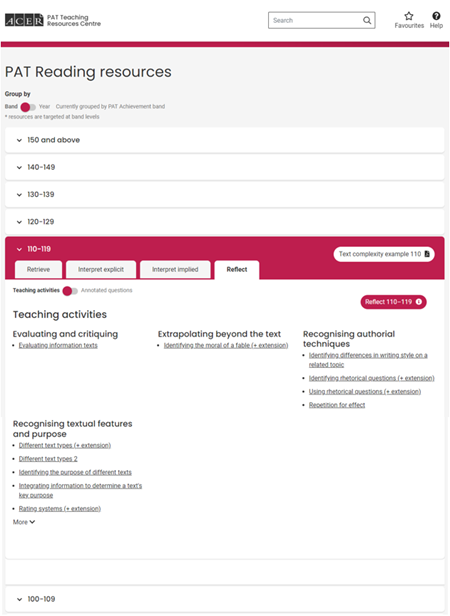
Linking the PAT Teaching Resources Centre to the new Australian Curriculum: English
Feature 4 May 2023 5 minute readJude Alexander, Research Fellow at ACER, deconstructed Version 9.0 of the Australian Curriculum: English and explained its alignment with the Reading teaching activities in the PAT Teaching Resources Centre.
In a practical webinar session, Ms Alexander took attendees through a Reading teaching activity titled ‘Evaluating information texts’. She talked through the activity itself, the learning progression underpinned by the PAT Teaching Resources Centre and how these resources can be linked to reading comprehension within the Literacy, Language and Literature strands in the new Australian Curriculum.
Ms Alexander explained that the PAT Teaching Resources Centre is based on an evidence-based learning progression, whereas the Australian Curriculum is a much broader document about what you are teaching your students.
‘We want to point out where the 2 systems are linked and how they are aligned to each other.’
Learning progression in the PAT Teaching Resources Centre
In the PAT Teaching Resources Centre, resources are organised by band, which illustrates the learning progression at the heart of the PAT Teaching Resources Centre.

The bands in the Teaching Resources Centre illustrate the learning progression.
For this example, Ms Alexander selected the 110–119 band, which is the average reading comprehension level of a year 4 student. However, as the activities are based on a learning progression, they can be given to any student where this activity is appropriate to their zone of proximal development.
All the headings within the bands are, in fact, reading processes that are used throughout the PAT scale. The 4 processes in this example are:
- Evaluating and critiquing
- Extrapolating beyond the text
- Recognising authorial techniques
- Recognising textual features and purposes
Curriculum links in the teaching activities
Next, breaking down the teaching activity 'Evaluating information texts', the details show the curriculum links relevant to the teaching activity.

The link for this activity is Australian Curriculum (Version 9.0) code AC9E4LY05. It’s worth breaking the code down, because there are some changes to the new version of the Australian Curriculum.
In order, the letters and numbers in AC9E4LY05 represent:
- AC – Australian Curriculum
- 9 – version 9
- E – English
- 4 – Year 4
- LY – Literacy
- 05 – the fifth curriculum element within literacy
The content description for this curriculum code is: ‘students learn to: use comprehension strategies such as visualising, predicting, connecting, summarising, monitoring and questioning to build literal and inferred meaning, to expand topic knowledge and ideas, and evaluate texts.’
Ms Alexander explored the content elaborations for this curriculum code, and identified 2 direct links with the teaching activity:
- identifying evidence and reasoning used by authors to support points or arguments
- evaluating an author’s use of evidence to support arguments
She then demonstrated the similarities between the reading comprehension content elaborations in the new Australian Curriculum and the PAT Teaching Resources Centre reading processes.
Extending the teaching activity
Finally, taking that same teaching activity, Ms Alexander discussed ways to link it to other curriculum elements.
Here is an example from the activity:

‘As written, it’s maybe a sentence or two of writing,’ she said. ‘But if you are doing project-based learning, you could embed this task into the topic you are working through and access that greater depth of knowledge. Then you could link to the writing element in the Australian Curriculum.’
This session demonstrated that the PAT Teaching Resources Centre is a flexible tool that can address the curriculum in many ways, supporting targeted learning for every student.
Learn more
If you would like to view the full presentation, register to access the webinar.
If you have any queries, please reach out to the team at sales@acer.org.